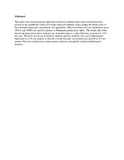| dc.contributor.author | Nyariki, D M | |
| dc.contributor.author | Thirtle, C G | |
| dc.date.accessioned | 2013-05-06T08:37:54Z | |
| dc.date.available | 2013-05-06T08:37:54Z | |
| dc.date.issued | 2000-12 | |
| dc.identifier.citation | AgEcon Search 39(4), 2000 | en |
| dc.identifier.uri | http://purl.umn.edu/54220 | |
| dc.identifier.uri | http://erepository.uonbi.ac.ke:8080/xmlui/handle/123456789/19307 | |
| dc.description.abstract | This paper uses non-parametric approach to measure technical innovation and productivity growth at the smallholder farm-level in dry-land sub-Saharan Africa during the initial years of the structural adjustment programmes for agriculture. Data from Kenya for two production years, 1991/2 and 1995/6 are used to construct a Malmquist productivity index. The results show that the rise in input prices led to reduced use of modern inputs, so that efficiency increased at 12% per year. However, lower use of modern varieties and less fertiliser also gave technological regression at 2.5% per annum, so that the overall outcome was productivity growth of 3% per annum. However, productivity improvement cannot be sustainable without technological progress. | en |
| dc.language.iso | en | en |
| dc.subject | Technical innovation | en |
| dc.subject | Farm productivity | en |
| dc.subject | Dryland | en |
| dc.subject | Africa | en |
| dc.subject | Structural adjustments | en |
| dc.subject | Smallholders | en |
| dc.subject | Kenya | en |
| dc.title | Technical innovation and farm productivity growth in dryland Africa: The effects of structural adjustment on smallholders in Kenya | en |
| dc.type | Article | en |
| local.publisher | Department of Agricultural Economics, University of Nairobi, Kenya | en |

